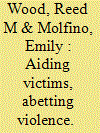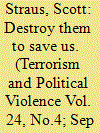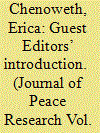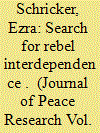|
|
|
Sort Order |
|
|
|
Items / Page
|
|
|
|
|
|
|
| Srl | Item |
| 1 |
ID:
147487


|
|
|
|
|
| Summary/Abstract |
Annual allocations of bilateral and multilateral humanitarian assistance to conflict-affected states total billions of dollars each year. Humanitarian assistance plays a vital role in sustaining vulnerable populations. However, inflows of such aid may also exacerbate violence by both threatening insurgents and creating incentives for these groups to extend or deepen control over the areas in which aid is concentrated. Insurgent efforts to ameliorate threats and co-opt resources ultimately raise the risk of conflict between insurgent and counterinsurgent forces. We use recently constructed geo-located data on both aid commitments and conflict events in a sample of twenty sub-Saharan African countries during the post–Cold War era to evaluate the impact of aid on violence. Even after accounting for the non-random assignment of aid within conflict zones, we find that humanitarian aid increases the frequency of subsequent violent engagements between rebel and government forces in the areas in which aid is concentrated. Importantly, however, we find no evidence that other forms of foreign development aid exacerbate or prolong violence in the areas in which they are allocated.
|
|
|
|
|
|
|
|
|
|
|
|
|
|
|
|
| 2 |
ID:
141094


|
|
|
|
|
| Summary/Abstract |
Debates about whether China's rise poses a threat or an opportunity for Taiwan have settled into a realist assumption that Beijing will continue to upset the balance of power and a liberal approach that believes the benefits of economic interdependence are leading to greater gains. Missing from this debate is a nuanced consideration of how Taiwan's policy elites view themselves and their position in cross-Strait relations. Taiwan's decision makers' views are deeply affected by, and interact with, factors and institutions on and beyond the island. This article offers a model of political processes – the staying power of the status quo and order of movement – as a possible route towards an explanation for Taiwan's position on cross-Strait negotiations. The conclusion is that the status quo position – de facto but not de jure independence – is becoming more entrenched with time. Taiwan's colours of partisanship, Blue and Green, are blending into Aquamarine.
|
|
|
|
|
|
|
|
|
|
|
|
|
|
|
|
| 3 |
ID:
114672


|
|
|
|
|
| Publication |
2012.
|
| Summary/Abstract |
Based on an analytic review of recent scholarly advances in genocide studies, this article investigates the causes, concept, and logic of genocide while suggesting a set of theoretical propositions and avenues for future research. Two emerging theoretical streams of literature on causes-strategic and ideological-highlight different dimensions of genocide and should be thought of as compatible. The study of genocide should be embedded in a broader study of political violence; the two literatures have been strangely cloistered from each other. To that end, genocide should be conceptualized as group-selective, large-scale violence whose purpose is group destruction. This stands in contrast to violence that is individually selective or indiscriminate; small-scale and not sustained across time and space; and whose purpose is repression, communication, or some other outcome short of group destruction. To develop existing theory and to bring the study of genocide closer to the literature on violence, studying variation in outcomes is essential; that is, students of genocide should ask why genocide and not another outcome occurs, rather than only studying common patterns among genocide cases. Similarly, rather than study primarily sources of escalation and accelerators of violence, scholars should also theorize restraint and decelerators of violence. Further, scholars of genocide should focus attention on the interaction between national and sub-national actors as well as periods of escalation or de-escalation. In these ways and others proposed in the essay, genocide studies can build on recent gains and develop a broader and more coherent field of theoretical inquiry.
|
|
|
|
|
|
|
|
|
|
|
|
|
|
|
|
| 4 |
ID:
190016


|
|
|
|
|
| Summary/Abstract |
In the past decade, myriad studies have explored the effects of nonviolent resistance (NR) on outcomes including revolutionary success (short-term and long-term) and democratization, and how nonviolent mobilization can play a similar role to violence in affecting social change in some settings. This special issue seeks to advance our understanding of the role of nonviolence by tackling some key assumptions in existing work that are complicated by historical and contemporary realities of deepening polarization worldwide. This issue addresses four key areas within conflict and peace research that limit our ability to make sense of NR: (a) the fragmented nature of civil resistance campaigns in terms of supporters and demands; (b) the increasing prevalence of authoritarian or anti-egalitarian nonviolent campaigns; and (c) the complicated nature of revolutionary success. Cutting across all three of these substantive areas is another key area, which is: (d) the United States as an increasingly salient site of conflict and contention.
|
|
|
|
|
|
|
|
|
|
|
|
|
|
|
|
| 5 |
ID:
112854


|
|
|
|
|
| Publication |
2012.
|
| Summary/Abstract |
The most prominent form of violent conflict in the world today occurs within states
rather than between them. Since 1945, over 75 percent of militarized disputes have
been civil conflicts.
1
From the African continent to the Balkans, civil wars have
raged and self-determination movements have mobilized for collective violence.
Conflict over identity has emerged as a central problem for nations and the internal
community as nationalist groups battle the state and each other in places like Iraq
and Sudan.
The comparative decline of conventional interstate war casts a spotlight on the
myriad of conflicts involving nonstate actors, be they in conflict with each other
or with existing states. We define a nonstate actor as an organized political actor not
directly connected to the state but pursing aims that affect vital state interests. The
dominant approach to analysis of conflicts involving nonstate actors views them,
like interstate conflicts, as the outcome of bargaining between antagonists (Fearon
1995; for review, see Walter 2009). This bargaining framework entails identifying
key players-typically just two-and specifying their preferences, the limits of their
capabilities and resolve, and the information they have about each other.
2
Given
such information, analysts derive predictions about when their strategic interaction
will result in conflict, as well as the characteristics of that conflict.
|
|
|
|
|
|
|
|
|
|
|
|
|
|
|
|
| 6 |
ID:
151113


|
|
|
|
|
| Summary/Abstract |
The existing conflict literature tends to treat interdependence between rebel groups as a binary category: either groups are allied or unallied, fragmented or unified, interdependent or independent. Yet much of our qualitative knowledge suggests that interdependence is better understood as a matter of degree where certain groups exert a disproportionate influence over their counterparts. The challenge is how to identify the degree of interdependence in practice. As a solution, I conceptualize interdependence as a property of a system of interactions between rebel groups and government forces within and across borders. My approach is to model the entire system of interactions in order to test hypotheses related to the directionality of influence and the potential for military coordination between groups. I demonstrate the utility of this approach by examining the relationship between Pakistan and the two major factions which make up the Taliban organization – the Afghan and Pakistani Taliban. I analyze the triangular system with a vector autoregressive model and monthly time series data on violent actions initiated by each group from January 2008 to February 2013. The substantive findings support much of the received wisdom concerning Pakistan’s disparate relationship to both groups, which is characterized by antagonism with the Pakistani Taliban and collusion with the Afghan Taliban. The results also suggest that the claims of interdependence between the two Taliban groups have been overstated.
|
|
|
|
|
|
|
|
|
|
|
|
|
|
|
|
|
|
|
|
|